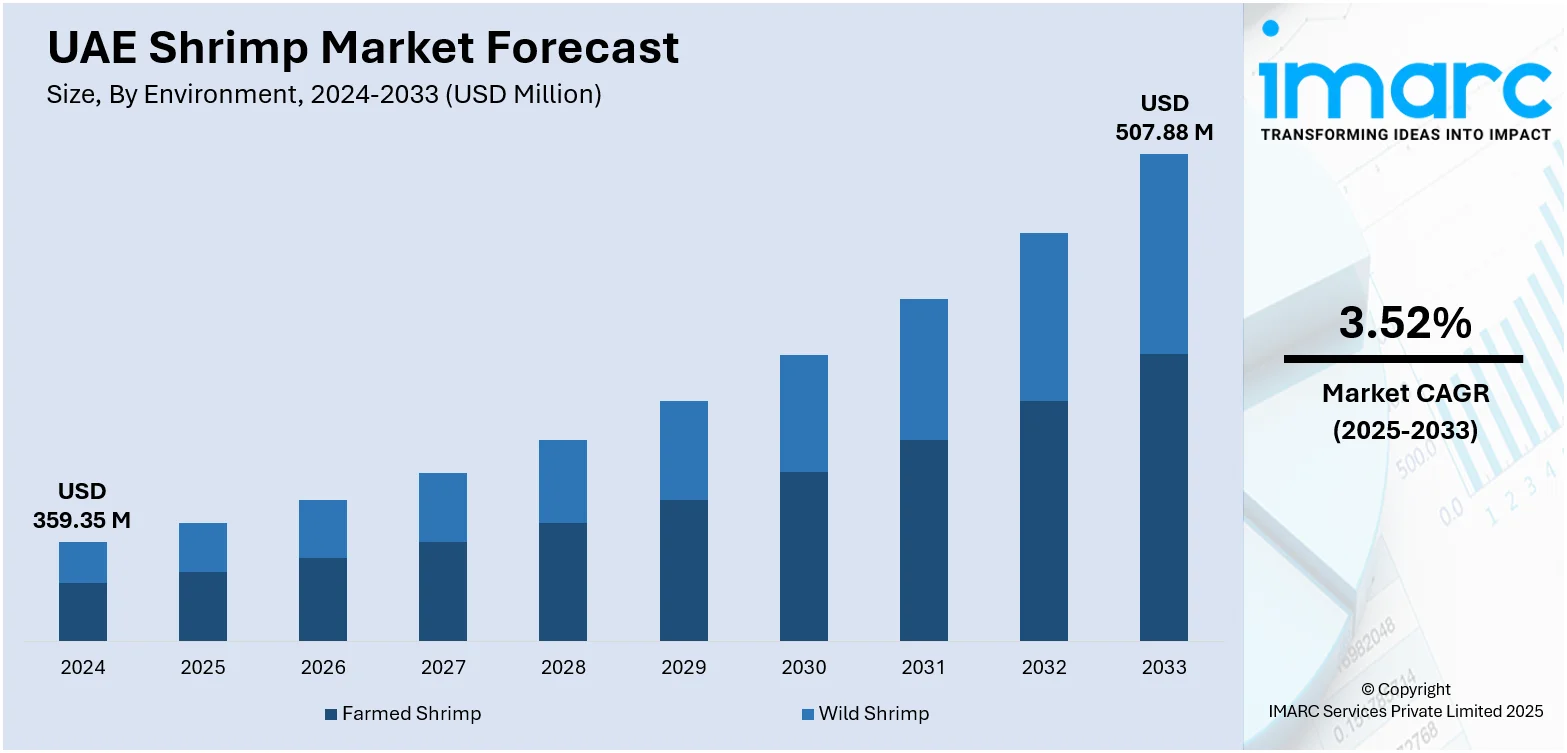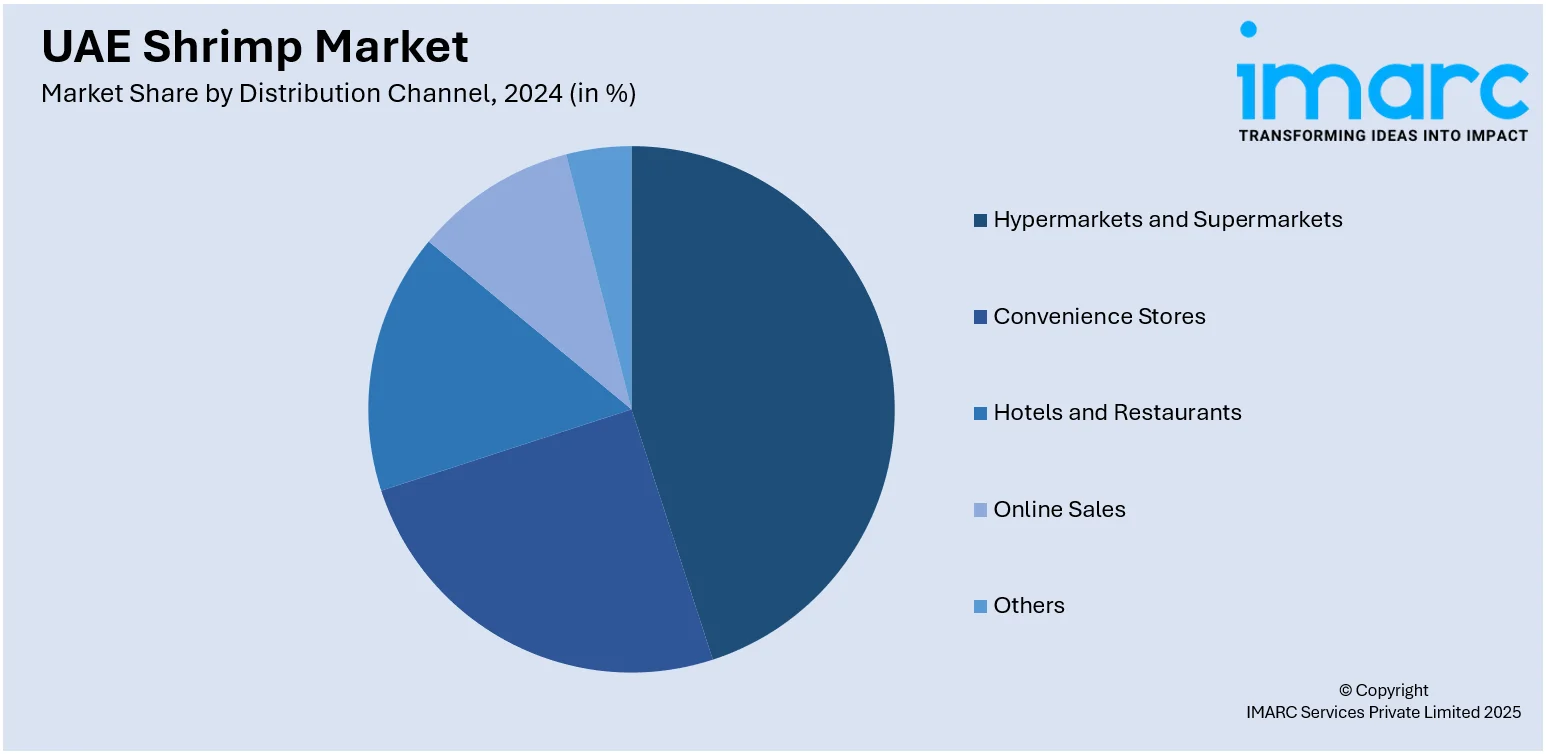
UAE Shrimp Market Size, Share, Trends and Forecast by Environment, Species, Shrimp Size, Distribution Channel, and Region, 2025-2033
UAE Shrimp Market Overview:
The UAE shrimp market size reached USD 359.35 Million in 2024. The market is projected to reach USD 507.88 Million by 2033, exhibiting a growth rate (CAGR) of 3.52% during 2025-2033. The market is expanding, driven by rising consumer demand for sustainable, high-quality seafood. With a focus on wild-caught and hormone-free products, innovations in shrimp farming technologies are strengthening local production. These trends are expected to positively impact UAE Shrimp market share, reducing dependence on imports.
|
Report Attribute
|
Key Statistics
|
|---|---|
|
Base Year
|
2024 |
|
Forecast Years
|
2025-2033
|
|
Historical Years
|
2019-2024
|
| Market Size in 2024 | USD 359.35 Million |
| Market Forecast in 2033 | USD 507.88 Million |
| Market Growth Rate 2025-2033 | 3.52% |
UAE Shrimp Market Trends:
Growing Demand for Sustainable Shrimp
The growth of UAE shrimp markets is being driven significantly by the rising consumer trend towards sustainable and ethically produced seafood. As the concern for environmental sensitivity increases, consumers are calling for healthier and more responsibly produced products. The concern for overfishing and unsustainable aquaculture has driven more demand for farmed and wild-caught shrimp that meet stringent environmental and ethical requirements. This has led to more and more brands providing products free from antibiotics and hormones, making sure that they are compliant with the growing demand for clean, sustainable food by consumers. Moreover, the rising popularity of alternative diets like keto and high-protein diets is driving the consumption of shrimp in the region. Being a good source of protein, shrimp is very much in sync with the nutritional demands of these diets, further stimulating market demand. Recent products, like Al Islami Foods' high-end wild-caught Extra-Large Shrimps, are a good example of the trend, providing shrimp that contain no additives and are frozen to preserve nutrients. These innovations in products are responding to changing consumer demands, creating the growth for the market and supporting more sustainable shrimp production in the area.

To get more information on this market, Request Sample
Technological Developments Driving Production
Technological innovations are at the forefront of transforming the UAE Shrimp market growth by enhancing shrimp cultivation and local production. With the aim to minimize dependence on imported shrimp, technological innovations in aquaculture are serving to supply the increasing demand for fresh, high-quality shrimp. One of such innovations is the introduction of land-based shrimp culture systems based on superior filtration and recirculating aquaculture systems (RAS). Such technologies enhance water efficiency, production levels, and environmental footprint. Additionally, technologies such as computerized monitoring systems, which monitor shrimp health and growth, guarantee greater yield and quality control. Collaborations such as the partnership between ADQ and Aqua Development seek to utilize such technologies to pilot and develop land-based shrimp farming in the UAE, promoting greater local production of shrimp. As these technologies continue to develop, they hold the potential to change the manner in which shrimp are produced in the country to make production more efficient and affordable. Through the application of these advanced techniques, the UAE will be capable of increasing domestic shrimp production, thereby reducing the country's reliance on imports and establishing it as a leader in sustainable seafood production in the Middle East region.
UAE Shrimp Market Segmentation:
IMARC Group provides an analysis of the key trends in each segment of the market, along with forecasts at the country and regional level for 2025-2033. Our report has categorized the market based on environment, species, shrimp size, and distribution channel.
Environment Insights:
- Farmed Shrimp
- Wild Shrimp
The report has provided a detailed breakup and analysis of the market based on the environment. This includes farmed shrimp and wild shrimp.
Species Insights:
- Penaeus Vannamei
- Penaeus Monodon
- Macrobrachium Rosenbergii
- Others
The report has provided a detailed breakup and analysis of the market based on the species. This includes penaeus vannamei, penaeus monodon, macrobrachium rosenbergii, and others.
Shrimp Size Insights:
- <21
- 21-25
- 26-30
- 31-40
- 41-50
- 51-60
- 61-70
- >70
The report has provided a detailed breakup and analysis of the market based on the shrimp size. This includes <21, 21-25, 26-30, 31-40, 41-50, 51-60, 61-70, and >70.
Distribution Channel Insights:

- Hypermarkets and Supermarkets
- Convenience Stores
- Hotels and Restaurants
- Online Sales
- Others
A detailed breakup and analysis of the market based on the distribution channel have also been provided in the report. This includes hypermarkets and supermarkets, convenience stores, hotels and restaurants, online sales, and others.
Regional Insights:
- Dubai
- Abu Dhabi
- Sharjah
- Others
The report has also provided a comprehensive analysis of all the major regional markets, which include Dubai, Abu Dhabi, Sharjah, and others.
Competitive Landscape:
The market research report has also provided a comprehensive analysis of the competitive landscape. Competitive analysis such as market structure, key player positioning, top winning strategies, competitive dashboard, and company evaluation quadrant has been covered in the report. Also, detailed profiles of all major companies have been provided.
UAE Shrimp Market News:
- December 2024: ADQ partnered with Aqua Development to launch a pilot shrimp farming facility in KEZAD, UAE. The initiative aimed to enhance local shrimp production through the use of advanced, sustainable aquaculture methods. This development is expected to reduce the UAE’s reliance on shrimp imports, boosting local market growth and food security.
- July 2024: Al Islami Foods launched a premium range of wild-caught extra-large shrimps, free from hormones and antibiotics. This new product, catering to health-conscious consumers, reinforced the UAE’s shift towards sustainable, high-quality seafood, meeting the rising demand for nutritious, ethically sourced shrimp options in the market.
UAE Shrimp Market Report Coverage:
| Report Features | Details |
|---|---|
| Base Year of the Analysis | 2024 |
| Historical Period | 2019-2024 |
| Forecast Period | 2025-2033 |
| Units | Million USD |
| Scope of the Report | Exploration of Historical Trends and Market Outlook, Industry Catalysts and Challenges, Segment-Wise Historical and Future Market Assessment:
|
| Environments Covered | Farmed Shrimp, Wild Shrimp |
| Species Covered | Penaeus Vannamei, Penaeus Monodon, Macrobrachium Rosenbergii, Others |
| Shrimp Sizes Covered | <21, 21-25, 26-30, 31-40, 41-50, 51-60, 61-70, >70 |
| Distribution Channels Covered | Hypermarkets and Supermarkets, Convenience Stores, Hotels and Restaurants, Online Sales, Others |
| Regions Covered | Dubai, Abu Dhabi, Sharjah, Others |
| Customization Scope | 10% Free Customization |
| Post-Sale Analyst Support | 10-12 Weeks |
| Delivery Format | PDF and Excel through Email (We can also provide the editable version of the report in PPT/Word format on special request) |
Key Questions Answered in This Report:
- How has the UAE shrimp market performed so far and how will it perform in the coming years?
- What is the breakup of the UAE shrimp market on the basis of environment?
- What is the breakup of the UAE shrimp market on the basis of species?
- What is the breakup of the UAE shrimp market on the basis of shrimp size?
- What is the breakup of the UAE shrimp market on the basis of distribution channel?
- What is the breakup of the UAE shrimp market on the basis of region?
- What are the various stages in the value chain of the UAE shrimp market?
- What are the key driving factors and challenges in the UAE shrimp market?
- What is the structure of the UAE shrimp market and who are the key players?
- What is the degree of competition in the UAE shrimp market?
Key Benefits for Stakeholders:
- IMARC’s industry report offers a comprehensive quantitative analysis of various market segments, historical and current market trends, market forecasts, and dynamics of the UAE shrimp market from 2019-2033.
- The research report provides the latest information on the market drivers, challenges, and opportunities in the UAE shrimp market.
- Porter's Five Forces analysis assists stakeholders in assessing the impact of new entrants, competitive rivalry, supplier power, buyer power, and the threat of substitution. It helps stakeholders to analyze the level of competition within the UAE shrimp industry and its attractiveness.
- Competitive landscape allows stakeholders to understand their competitive environment and provides an insight into the current positions of key players in the market.
Need more help?
- Speak to our experienced analysts for insights on the current market scenarios.
- Include additional segments and countries to customize the report as per your requirement.
- Gain an unparalleled competitive advantage in your domain by understanding how to utilize the report and positively impacting your operations and revenue.
- For further assistance, please connect with our analysts.
 Request Customization
Request Customization
 Speak to an Analyst
Speak to an Analyst
 Request Brochure
Request Brochure
 Inquire Before Buying
Inquire Before Buying




.webp)




.webp)












